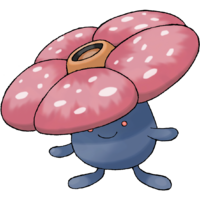Vileplume (Pokémon)
|
|
|
| ||||||||||||||
| ||||||||||||||
|
| |||||||||||||
|
| |||||||||||||
| ||||||||||||||
| ||||||||||||||
| ||||||||||||||
|
| |||||||||||||
|
| |||||||||||||
| ||||||||||||||
| ||||||||||||||
| ||||||||||||||
| ||||||||||||||
Vileplume (Japanese: ラフレシア Ruffresia) is a Grass/Poison-type Pokémon.
Biology
Physiology
Vileplume has a much larger "flower" on its head, and it still resembles a Rafflesia flower.
Gender differences
A female has fewer, but bigger, spots on its petals.
Special abilities
Vileplume scatters toxic spores and releases noxious gases.
Behavior
Habitat
Vileplume live in grassy plains, and can also be found in tropical areas such as jungles and swamps, where the ground is rich in nutrients.
Diet
Main article: Pokémon food
In the anime
Vileplume first appeared in Pokémon Scent-sation, being one of the Pokémon owned by the attendants at the Celadon Gym and was also seen at a party in The Battling Eevee Brothers. Those were cameo appearances.
Its first major appearance was in Holy Matrimony. The walking rafflesia flower was under the ownership of James's fiancée, Jessiebelle. Prior to the flashback when James ran away from home, it was once an Oddish.
A Vileplume was among the Pokémon that were captured and cloned by Mewtwo in Mewtwo Strikes Back.
Ash, Tracey and Jessie were affected by a Vileplume's Stun Spore in The Stun Spore Detour.
Groups of Vileplume and Bellossom were feuding with each other in Whichever Way the Wind Blows.
Nicolette used a Vileplume to battle May's Munchlax in May's Egg-Cellent Adventure.
A Vileplume appeared at the start of Leave It To Brocko!. It was running through the forest throughout the night after being woken with a shock when a Nuzleaf fell out of its tree, hitting the Vileplume on its head.
In the manga
Vileplume is one of the Pokémon owned by Erika in Pokémon Special.
In the TCG
- Main article: Vileplume (TCG)
Game data
Pokédex entries
| ||||||||||||||
| ||||||||||||||
| ||||||||||||||
| ||||||||||||||
| ||||||||||||||
| ||||||||||||||
Game locations
| |||||||||||||||||||||||||||||
| |||||||||||||||||||||||||||||
| |||||||||||||||||||||||||||||
| |||||||||||||||||||||||||||||
| |||||||||||||||||||||||||||||
| |||||||||||||||||||||||||||||
In side games
| Game | Location |
|---|---|
| Pokémon Snap | River |
| Pokémon Pinball: Ruby & Sapphire | Evolve from Gloom (Ruby Field) |
| Pokémon Trozei | Secret Storage 3 Mr. Who's Den |
| Pokémon Mystery Dungeon (Red and Blue) |
Evolve from Gloom |
| Pokémon Ranger | Sekra Mountain Range |
| Pokémon Mystery Dungeon (Time and Darkness) |
Evolve from Gloom |
| Pokémon Ranger Batonnage | Nurue Field |
Base stats
| Stat | Range | ||
|---|---|---|---|
| At Lv. 50 | At Lv. 100 | ||
HP: 75
|
135 - 182 | 260 - 354 | |
80
|
76 - 145 | 148 - 284 | |
85
|
81 - 150 | 157 - 295 | |
100
|
94 - 167 | 184 - 328 | |
90
|
85 - 156 | 166 - 306 | |
50
|
49 - 112 | 94 - 218 | |
Total: 480
|
Other Pokémon with this total | ||
Type effectiveness
Template:DP type effectiveness
In Generation I, the effectiveness of Bug-type moves is 400.
Learnset
Template:Evolved learnset intro
By leveling up
By TM/HM
|
|
|
| ||||||||||||||||||||||||||||||||||||||||||||||||||||||||||||||||||||||||||||||||||||||||||||||||||||||||||||||||||||||||||||||||||||||||||||||||||||||||||||||||||||||||||||||||||||||||||||||||||||||||||||||||||||||||||||||||||||||||||||||||||||||||||||||||||||||||||||||||||||||||||||||||||||||||||||||||||||
By breeding
| Move | Type | Cat. | Father |
|---|---|---|---|
| Charm* | Hoppip, Skiploom, Jumpluff | ||
| Flail* | Chikorita, Bayleef, Meganium Lotad, Lombre, Ludicolo | ||
| Ingrain | Tangela Sunkern, Sunflora Roselia Cacnea, Cacturne Carnivine Snover, Abomasnow Tangrowth | ||
| Razor Leaf | Bulbasaur, Ivysaur, Venusaur Bellsprout, Weepinbell, Victreebel Chikorita, Bayleef, Meganium Sunflora Tropius Turtwig,Grotle,Torterra Snover, Abomasnow | ||
| Swords Dance | Bulbasaur**, Ivysaur**, Venusaur** Oddish*/**, Gloom*/**, Vileplume*/** Paras**, Parasect**Bellsprout*/**, Weepinbell*/**, Victreebel*/** Exeggcute**, Exeggutor** Tangela** Chikorita**, Bayleef**, Meganium** Bellossom** Hoppip**, Skiploom**, Jumpluff** Sunkern**, Sunflora** Lotad**, Lombre**, Ludicolo** Seedot**, Nuzleaf**, Shiftry** Shroomish**, Breloom** Roselia** Cacnea**, Cacturne** Tropius** Turtwig**, Grotle**, Torterra** Budew**, Roserade** Cherubi**, Cherrim** Carnivine** Snover**, Abomasnow** Tangrowth** | ||
| Synthesis | Bulbasaur, Ivysaur, Venusaur Chikorita, Bayleef, Meganium Hoppip, Skiploom, Jumpluff Seedot, Nuzleaf, Shiftry Roselia Tropius Turtwig, Grotle, Torterra | ||
| Tickle | Tangela, Tangrowth | ||
| *Indicates moves only available through chain breeding. **Father needs to learn this move through TM. | |||
Side game data
Evolution
Sprites
| Gen | Game | ||||||
|---|---|---|---|---|---|---|---|
| I | Red | Blue | Yellow | Red (Ja) | Green | Back | |

|

|

|

| ||||
| II | Gold | Silver | Crystal | Back | |||

|

|

|

| ||||

|

|

|

| ||||
| III | Ruby | Sapphire | Emerald | FireRed | LeafGreen | Back | |

|

|

|

| ||||

|

|

|

| ||||
| IV | Diamond | Pearl | Platinum | HeartGold | SoulSilver | Back | |

|

|

|

| ||||

|

|

|

| ||||

|

|

|

| ||||

|

|

|

| ||||
| V | Black | White | Black 2 | White 2 | Back | ||

|

|

| |||||

|

|

| |||||

|

|

| |||||

|

|

| |||||
Trivia
- Vileplume shares the same species name with Bellsprout and Bellossom. They are all known as Flower Pokémon.
Origin
Vileplume, like Gloom, is based on the rafflesia arnoldii, a foul-smelling flower. This Pokémon more strongly resembles the flower than Gloom, which may represent the budding stage of the rafflesia.
Name origin
Vileplume's name comes from a combination of vile and plume. Its Japanese name is a corruption of the word rafflesia.
In other languages
- German: Giflor
- French: Rafflesia - From the flower of the same name.
- Korean: 라플레시아 Rapeullesia
- Chinese (Taiwan and Hong Kong): 霸王花 (Ba Wang Hua) - Chinese name of Rafflesia Arnoldii which it is based upon
External links
|
|
|

|
This Pokémon article is part of Project Pokédex, a Bulbapedia project that aims to write comprehensive articles on each Pokémon species, as well as Pokémon groups and forms. |
- Pokémon pages lacking disambiguation notices
- Pokémon in the Medium Slow experience group
- Pokémon in the Kanto Pokédex
- Pokémon in the Johto Pokédex
- Pokémon in the Hoenn Pokédex
- Body style 12 Pokémon
- Generation I Pokémon
- Grass-type Pokémon
- Poison-type Pokémon
- Dual-type Pokémon
- Pokémon without Hidden Abilities
- Red-colored Pokémon
- Gender-unknown Pokémon
- Plant group Pokémon
- Pages with broken file links
- Pokémon with a base stat total of 480
- Pokémon whose Special stat became their Special Attack
- Pokémon that are part of a three-stage evolutionary line


